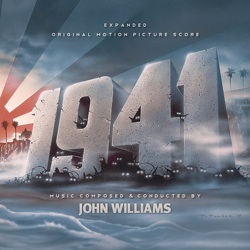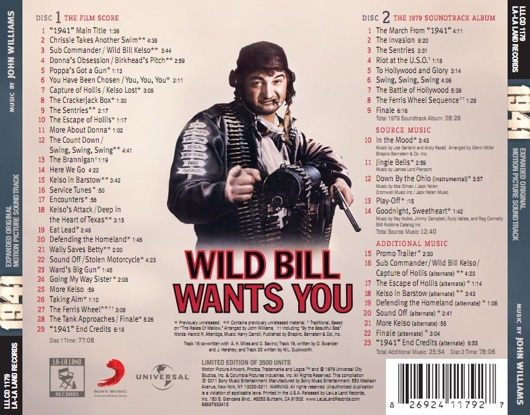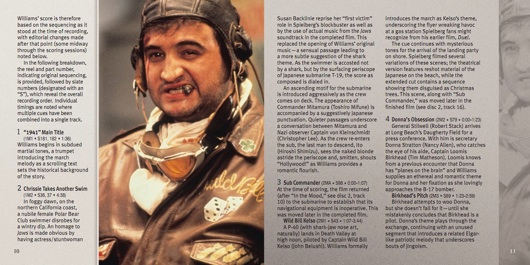BEHIND THE SCENES: LA-LA LAND RECORDS’ ‘1941 – EXPANDED EDITION’
By Jason LeBlanc
La-La Land Record’s Tuesday release of 1941: Expanded Edition is a landmark release in a lot of ways: The first Williams/Spielberg theatrical collaboration to be expanded by one of our beloved independent labels; La-La Land’s first plunge into the Universal Vaults; And a score done right in the middle of a string of untouchable Williams classics, finally expanded for the first time 32 years after the short Original Soundtrack album was released.
I contacted MV Gerhard of La-Land Records to ask him about how it came about, and he had this to say:
1941 really was a dream project for La-La Land. It’s a score we love with great passion and Mike Matessino produced as wonderful an album re-issue as we could have hoped for. We are grateful that we were able to secure the re-issue license from Sony Music and that Universal allowed us to expand it with all the previously unreleased material. Everyone is excited by the result and we of course are optimistic this release leads to further Universal projects for us, as well as more Spielberg/Williams collaborations. We hope everyone enjoys the listen and overall presentation. It’s been a blast!
I also was able to get the incredibly busy Mike Matessino – producer, edit, mixer, and liner note writer of the release – for the following exclusive interview:
Thanks for agreeing to be interviewed, Mike! La-La Land Record’s release of 1941 is a landmark release in a lot of ways. How and when did you become involved in the process?
A little checking into old emails reveals that on May 21, 2010, MV Gerhard appended a message about Alien Resurrection with: “by the way… wanna work on 1941?” I’m sure he was being wryly humorous, but from that moment I think it was clear that La-La Land was bringing me the opportunity to take complete charge of the release, producing as well as overseeing the audio and writing the liner notes.
The sound quality of the set is amazing! Can you tell us what source material was used, where it was located, what condition they were in, and what work had to be done to restore them?
The original first generation 16-track scoring masters were in the Universal vaults and they are pristine. They were transferred at 96k, 24 bit to Pro Tools at BluWave Audio on the Universal lot and I did a multi-track remix following John Neal’s usual methodology and carefully comparing it to the LP master for accuracy. The same tapes had been used to create the isolated score and extended version remix but this time around more attention was paid to getting it exactly right. Noises and anomalies were addressed in the usual way, but it was all in good shape so it was all about accurate mixing and editing.
Was the Promo Trailer music found with the rest of the source material, or in a different location entirely?
The Promo Trailer was at Universal but filed separately. At first two other elements for the trailer were found, both mono. Then the 16 track was located and transferred and I remixed it.
Was the restoration of the original 1979 LP done by remastering the original album master, or was it a total re-edit from scratch using the same source material as was used on disc 1?
I recreated the original album using my new mixes, so the quality is the same throughout the set. We found a 1/4″ LP master at Fox that I used for comparison. I did keep “Swing, Swing, Swing” from this album master because that mix was so different from the film version and I felt it should be preserved. The original album production materials were also at Fox and contained the discrete explosions and clean John Belushi vocal, so those came from that source.
What are your thoughts on Williams’ original 1979 LP presentation of the score? What music that he didn’t include out of that presentation do you think fans will enjoy hearing most on this new release?
The LP was a timid presentation compared to the double record sets for Star Wars, Superman and The Empire Strikes Back and considering the volume of music that was recorded for the film. Overall the decisions were good ones considering the limited running time of an LP. And let’s not forget it was 1941 and not a blockbuster space movie. There is so much music that wasn’t on it, however, it’s hard to say what will be most enjoyed. I think just the overall scope of the score is the revelation; there is amazing action music and it’s really as expansive as the Star Wars scores or Superman and it’s right in the middle of this amazing period where Williams seemed to be delivering one masterpiece after another. I’d go so far to say that it’s a more enjoyable score than Raiders.
One thing fans will love about this set is that it includes the “End Credits” in 3 different iterations: Without cannonade (Disc 1, track 29), with the cannonade used in the film (Disc 2, track 23), and with the cannonade used on the LP (Disc 2, track 9). However, the original LP also contained a unique edit of “End Credits” that Williams titled “The March From “1941″”, that became the basis for the concert version that continues to be played today, that also contained cannonade (Disc 2, track 1). Was it ever on the table to include this edit without cannonade somewhere on the set?
It was considered before we knew what we had and how it would time out. As you can tell we have two maxed-out discs. My feeling was that the cannonade is appropriate for the march because it is really a concert and album piece even though it’s done in concert without them. So I opted to have the full cue without the cannons play as the end credits of the main score with all the cannons found on disc 2. A version of the march without the cannons is easily edited.
At any point did you consider including the source cues into the flow of the main score rather than as separate bonus tracks? Was the fact that doing so would make the complete score presentation spill over onto a second disc a deciding factor? In general, what factors lead to you deciding to including source music in the flow of the main score (Outland) or not (Home Alone, Star Trek 5) when working on a film score release?
Sequencing sort of dictates itself as you move through a project and it’s really decided on a case-by-case basis. From the beginning I thought it was a fun idea to have all the source music in one section so that it played like a night at the U.S.O. The deciding factor was that all of Williams’ compositions, including “The Countdown” and “Swing, Swing, Swing” fit neatly on one disc. But whenever possible I wanted to facilitate listeners’ ability to playlist the score with the source music integrated into the narrative. As for the other titles you mentioned, Outland was sequenced the way Lukas Kendall wanted it, Star Trek V, I think, was a matter of balance to make the second disc longer and the fact that the source music seemed an unnecessary interruption of Jerry’s score. And as for Home Alone, the church sequence is so critical to the narrative that it had to be in sequence, especially since both “Star of Bethlehem” and “Carol of the Bells” are both melodically intrinsic to the score.
Speaking of source music, at any point was it on the table to include any of the existing music recordings used in the film that weren’t recorded by Williams on this release – namely “Daddy” and “Down By The Ohio” by the Andrew Sisters, and “Over The Waves”?
Nothing could be found on “Over the Waves” other than what was on the mono music stem. The two Andrews Sisters recordings were in my original proposal, but the licensing fees were prohibitive. They’re available on iTunes.
The version of the film Williams originally scored was different in a lot of ways from the theatrical version and the Extended version of the film, containing some footage not found in either and not containing some footage later added in re-shoots. In your work on this release, did you get to see anything from this, or any other, version of the film?
I didn’t actually see anything, but co-screenwriter Bob Gale was involved and he provided drafts of the screenplay and other recollections. Also involved was Jeff Cava, who’s now at Paramount but was at Universal when the extended version was assembled in the mid-1990s. He gave me all of his notes on the project. Hearing the uncut music and reading the scores revealed a lot about how the film came together and what was still in the film at the time it was scored.
What are your thoughts about the decision made to have Williams write a “Sing, Sing, Sing” homage, rather than edit the existing piece (which was played on set while choreographing and shooting the scene) to the final cut of the film? Do you like the way the Williams version came out? I’ve always marveled at how well it plays on its own, when at the same time its so perfectly synced to the on-screen action when watching the film. Williams is unparalleled in that regard.
“Swing, Swing, Swing” is masterful in every way. The whole movie is kind of in an alternate universe, so it makes sense that they have a slightly different version of “Sing, Sing, Sing.” Williams crafts it as a standalone swing piece while still managing to match the action like a piece of underscoring. It’s magical, and reminds me of “TIE Fighter Attack” from Star Wars in how it feels like the film was edited to an existing piece of music rather than music that was written for a piece of edited film.
Of the album version of “Swing, Swing, Swing”, the liner notes say that the album mix “reduces the more prominent dramatic overlays and flourishes featured in the film version”. Does this mean the material heard only in the film version was recorded separately from the rest of the cue?
Everything was recorded together and just mixed differently for the album.
Your liner notes mention all the leitmotif themes Williams interspersed throughout the score – the March (Kelso’s Theme), Donna’s Theme, the patriotic melody, Wally and Betty’s Theme, the “Call To Arms” motif, and the ammunition motif. Do you come up with the names of these themes yourself? How good are you at noticing the themes – do you pick them up right away, or are several listens required before noticing a melody that appears in multiple cues?
I came up with those myself as generally there’s no official name unless there’s a standalone piece of music written around one of them. It does sometimes take a few listens, which in the case of 1941 was no big sacrifice to make. But there’s nothing subtle about the score so Williams didn’t really use themes esoterically. When they’re used, you hear them.
I absolutely love the way “The Capture Of Hollis” and “Kelso Lost” are combined in track 7. Do you think the version of the film Williams scored intended the two cues to play back to back like that, or was that a creative liberty you took when assembling the album? Williams is a master at writing two separate pieces of music that dovetail together like they were always intended to be played that way.
The length of “Capture of Hollis” suggests that those two cues were not intended to go together. That section of the film was constantly changed, and Wild Bill’s flight over the Grand Canyon was a very late addition to the picture. It seems that most of the Christmas tree scene was intended to be unscored, as opposed to the TV version and extended video cut that covered it with bits of tracked music. It made sense to put the cues together as a track just to keep the continuity of the score. There’s an alternate on disc 2 that demonstrates the necessary musical adjustment for moving the Hollis Wood sequence earlier.
Where all of Williams’ original cue titles used for this release?
“Service Tunes” was a cue sheet title. The manuscript had it as “Various Service Tunes Etc.” Two other cue titles were shortened by one word for, as Captain Hook might say, reasons of good form. No titles were “made up.”
Our former forum moderator Neil S. Bulk is a “Production Assistant” on this release, and forum contributor John Takis is mentioned in the “Special Thanks” section. Can you tell us what it was they each contributed to the production of this release?
Neil has become a great collaborator and helps out to one degree or another on most of my projects. I don’t think anyone besides me worked on the audio on this one—I do get a little proprietary once in a while—,but there are a hundred other things that need to get done over the course of a project of this size, whether it’s data getting moved around, materials delivered, picked up or whatever. Neil is also a great resource in the home stretch as a particularly sensitive set of eyes and ears looking over the booklet and listening to the mixes and master references. A lot of little fixes get implemented because of his attentiveness. John, I think, provided the Varese release of the original album, which I wanted to compare to the Bay Cities version just to be thorough.
Why do you think it is that this score isn’t commonly listed as a favorite among Williams’ oeuvre? The short OST, the critical failure of the film, or perhaps people don’t realize there are many more themes to the score than just the March?
There’s a stigma about the movie, for sure. Plus it’s simply not a brand name like Star Wars, Superman, Indiana Jones or Harry Potter. Not realizing there is more to the score than the march could have something to do with the fact that there is so much noise in the film that the casual viewer will not have his or her attention focused on the music. The LP doesn’t really represent the full scope of the score, so I absolutely think that the full presentation will be very satisfying.
Do you think this release will change people’s opinions of the score?
It won’t necessarily change opinions because so much of the score was already heard on the isolated score track on Laserdisc and DVD, but proper presentation and sound quality will hopefully also play a role.
And finally Mike, putting aside the music for a second – what are your thoughts on 1941, the movie itself?
I think 1941 is essential to understanding Steven Spielberg’s films. By his own admission he was drunk with power at the time, yet his unique vision somehow comes through all the mayhem and destruction. There are a lot of themes in the film that he continued to explore later. This movie shows that talent in a raw, undisciplined state. It’s Spielberg channeling his inner 10 year-old and running wild on Hollywood backlots and soundstages. So if you like his films… and it would hard to be a fan of John Williams’ music if you didn’t… you really need 1941 to put everything else in perspective. There’s a lot of great talent in the film but the original idea got lost when uncertainty about the humor led to a “noisier must be funnier” approach. The end result is visually spectacular and sometimes you can hardly believe what you’re seeing. It isn’t terribly laugh-out-loud funny but its pedigree is such that time has been very kind to it.
Mike, thanks so much for giving us some of your valuable time. Before you go, any hints you can give us on what Williams releases could be coming down the pipeline soon?
There’s one I worked on that I expect will be announced before the ink completely dries on this interview.
Thanks again Mike. Looking forward to your next release!
Mike Matessino is a prominent mixer / editor, soundtrack producer and film music preservationist. Visit his website for a complete list of projects he has worked on: www.mikematessino.com
Jason LeBlanc can be reached on the JWFan forums



